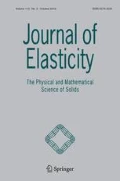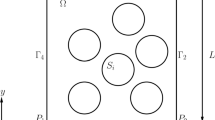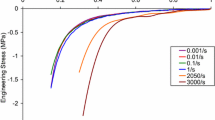Abstract
This paper proposes a new isotropic hyperelastic model for polymer foam, which explicitly models the micromechanical influence of changes in porosity. The foam is treated as a matrix of compressible solid material with evacuated pores that cause soft response for low pressures. In its general form, the strain energy of the foam depends on the strain energy of the solid material and on the porosity, which is taken to be a function of the total dilatation. This function adds only two material constants. One is the stress free porosity and the other controls the magnitude of the low pressure response of the foam. In contrast with other formulations, the proposed model naturally transitions to the response of the solid as the porosity approaches zero in hydrostatic compression.






Similar content being viewed by others
References
Blatz, P.J., Ko, W.L.: Application of finite elastic theory to the deformation of rubbery materials. Trans. Soc. Rheol. 6, 223–252 (1962)
Bridgman, P.W.: The compression of sixty-one solid substances to \(25{,}000~\mbox{kg}/\mbox{cm}^{2}\), determined by a new rapid method. Proc. Am. Acad. Arts Sci. 76, 9–24 (1945)
Ciambella, J., Saccomandi, G.: A continuum hyperelastic model for auxetic materials. Proc. R. Soc. Lond. A 470, 20130691 (2014)
Choi, J.B., Lakes, R.S.: Non-linear properties of polymer cellular materials with a negative Poisson’s ratio. J. Mater. Sci. 27, 4678–4684 (1992)
Ogden, R.W.: Large deformation isotropic elasticity—on the correlation of theory and experiment for compressible rubberlike solids. Proc. R. Soc. Lond. A 328, 567–583 (1972)
Storåkers, B.: On material representation and constitutive branching in finite compressible elasticity. J. Mech. Phys. Solids 34, 125–145 (1986)
Deshpande, V.S., Fleck, N.A.: Multi-axial yield behaviour of polymer foams. Acta Mater. 41, 1859–1866 (2001)
Dorfmann, A., Fuller, K.N.G., Ogden, R.W.: Shear, compressive and dilatational response in rubberlike solids subjected to cavitation damage. Int. J. Solids Struct. 39, 1845–1861 (2002)
Dorfmann, A.: Stress softening of elastomers in hydrostatic tension. Acta Mech. 165, 117–137 (2003)
Danielsson, M., Parks, D.M., Boyce, M.C.: Constitutive modeling of porous hyperelastic materials. Mech. Mater. 36, 347–358 (2004)
Mihai, L.A., Wyatt, H., Goriely, A.: A microstructure-based hyperelastic model for open-cell solids. SIAM J. Appl. Math. 77, 1397–1416 (2017)
Mihai, L.A., Wyatt, H., Goriely, A.: Microstructure-based hyperelastic models for closed-cell solids. Proc. R. Soc. A, Math. Phys. Eng. Sci. 473, 20170036 (2017)
Safar, A., Mihai, L.A.: The nonlinear elasticity of hyperelastic models for stretch-dominated cellular structures. Int. J. Non-Linear Mech. 106, 144–154 (2018)
Lewis, M.: A robust, compressible, hyperelastic constitutive model for the mechanical response of foamed rubber. Tech. Mech. 36, 88–101 (2016)
Rubin, M.B., Elata, D., Attia, A.V.: Modeling added compressibility of porosity and the thermomechanical response of wet porous rock with application to Mt. Helen Tuff. Int. J. Solids Struct. 33, 761–793 (1996)
Stacuzzi, A., Rubin, M.B.: A thermomechanical theory for porous tissues with diffusion of fluid including osmotic effects. Mech. Res. Commun. (2019). https://doi.org/10.1016/j.mechrescom.2019.04.007
Landervik, M., Larson, R.: Modeling of large inelastic deformations of foams with respect to the point of compaction. Eur. J. Mech. A, Solids 27, 234–246 (2008)
Markert, B.: A biphasic continuum approach for viscoelastic high-porosity foams: comprehensive theory, numerics, and application. Arch. Comput. Methods Eng. 15, 371–446 (2008)
Seibert, H., Scheffer, T., Diebels, S.: Thermomechanical characterisation of cellular rubber. Contin. Mech. Thermodyn. 28, 1495–1509 (2016)
Danielsson, M., Parks, D.M., Boyce, M.C.: Three-dimensional micromechanical modeling of voided polymeric materials. J. Mech. Phys. Solids 50, 351–379 (2002)
Rubin, M.B., Einav, I.: A large deformation breakage model of granular materials including porosity and inelastic distortional deformation rate. Int. J. Eng. Sci. 49, 1151–1169 (2011)
Hollenstein, M., Jabareen, M., Rubin, M.B.: Modeling a smooth elastic–inelastic transition with a strongly objective numerical integrator needing no iteration. Comput. Mech. 52, 649–667 (2013)
Hollenstein, M., Jabareen, M., Rubin, M.B.: Erratum to: Modeling a smooth elastic–inelastic transition with a strongly objective numerical integrator needing no iteration. Comput. Mech. 55, 453 (2015)
Acknowledgements
M.B. Rubin acknowledges partial support from his Gerard Swope Chair in Mechanics and the generous hospitality of the Department of Civil Engineering at Tufts University for hosting him during part of his sabbatical leave from Technion. The work by L. Dorfmann was supported, in part, by a Faculty Research Award provided by Tufts University.
Author information
Authors and Affiliations
Corresponding author
Additional information
Publisher’s Note
Springer Nature remains neutral with regard to jurisdictional claims in published maps and institutional affiliations.
Rights and permissions
About this article
Cite this article
Rubin, M.B., Dorfmann, L. A Hyperelastic Model for Soft Polymer Foam Including Micromechanics of Porosity. J Elast 138, 205–220 (2020). https://doi.org/10.1007/s10659-019-09740-0
Received:
Published:
Issue Date:
DOI: https://doi.org/10.1007/s10659-019-09740-0




